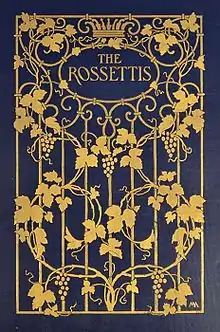Elisabeth Luther Cary | |
|---|---|
 The Rossettis by Elisabeth Luther Cary | |
| Born | May 18, 1867 Brooklyn, New York |
| Died | July 13, 1936 Brooklyn, New York |
| Nationality | American |
| Occupation(s) | Writer and art critic |
Elisabeth Luther Cary (May 18, 1867 – July 13, 1936) was an American writer and art critic.
Early life
Born in Brooklyn, New York, she was the daughter of Edward and Elisabeth (Luther) Cary. Her father was editor of the Brooklyn Union and later became an editorial writer for The New York Times.[1] Elisabeth was privately educated and from 1885–1898 she studied art.
Career
From 1893–1895, she translated three novels from French.[2] In the years that followed she published a series of studies on prominent literary figures. In 1904, she collaborated with Annie M. Jones to produce a book of recipes inspired by quotes from famous literary figures titled, Books and My Food.[3] She began publishing a monthly small art magazine called The Scrip in 1905.[4]
In 1908, she was named the first full-time art critic for The New York Times,[5] where she worked for the next twenty five years.[6] Following World War I, she helped encourage the founding of industrial arts schools and the introduction of machinery into the studio.[7]
Death
After living in Brooklyn her entire life, she died of heat exhaustion in 1936. She was buried in Greenwood Cemetery, Brooklyn.[6]
Bibliography
- August Lepère (1914).
- Artists Past and Present - Random Studies (1909).
- Honoré Daumier, a collection of his social and political caricatures together with an introductory essay on his art (1907).
- The works of James McNeill Whistler: a study (1907).
- The art of William Blake: his sketch-book, his water-colours, his painted books (1907).
- The novels of Henry James: a study (1905) with Frederick Allen King.
- Emerson, poet and thinker (1904).
- Books and my food: with literary quotations and original recipes for every day in the year (1904) with Annie M. Jones.
- William Morris: poet, craftsman, socialist (1902).
- The Rossettis: Dante Gabriel and Christina (1900).
- Browning, poet and man: a survey (1898).
- Tennyson: his homes, his friends, and his work (1898).
Translations
- Vte. Eugène-Melchior Vogüé, Russian Portraits (1895).
- Pierre Maël, The Land of the Tawny Beasts (1895).
- Francisque Sarcey, Recollections of Middle Life (1893).
- Edouard Rod, Father and Son
References
- ↑ "Funeral of Edward Cary.; Service for Times Editorial Writer Attended by Many Who Had Admired and Loved Him". The New York Times. May 26, 1917.
- ↑ Hamersly, Lewis Randolph (1907). Frank R. Holmes (ed.). Who's who in New York City and State. L.R. Hamersly Co. p. 255.
- ↑ Schoonover, David. "Books and My Food". Iowa Szathmáry Culinary Arts Series. University of Iowa Press. Retrieved 2011-06-23.
- ↑ Leonard, John William (1914). Woman's who's who of America: a biographical dictionary of contemporary women of the United States and Canada, 1914-1915. American Commonwealth Co. p. 166. ISBN 0-8103-4018-6.
- ↑ Olsen, Kirstin (1994). Chronology of women's history. Greenwood Publishing Group. p. 184. ISBN 0-313-28803-8.
- 1 2 James, Edward T.; James, Janet Wilson (1974). Paul S. Boyer (ed.). Notable American Women 1607–1950: A Biographical Dictionary. Dumbarton Oaks Colloquium Series in the History of Landscape Architecture. Harvard University Press. p. 298. ISBN 0-674-62734-2.
- ↑ Marquardt, Virginia Hagelstein (Spring 1988). "Louis Lozowick: From "Machine Ornaments" to Applied Design, 1923–1930". The Journal of Decorative and Propaganda Arts. 8: 40–57. JSTOR 1503969.
External links
- Works by Elisabeth Luther Cary at Project Gutenberg
- Works by or about Elisabeth Luther Cary at Internet Archive
- "Elisabeth Luther Cary". Historical and Public Figures: A General Portrait File to the 1920s. The New York Public Library. Retrieved 2011-06-23.